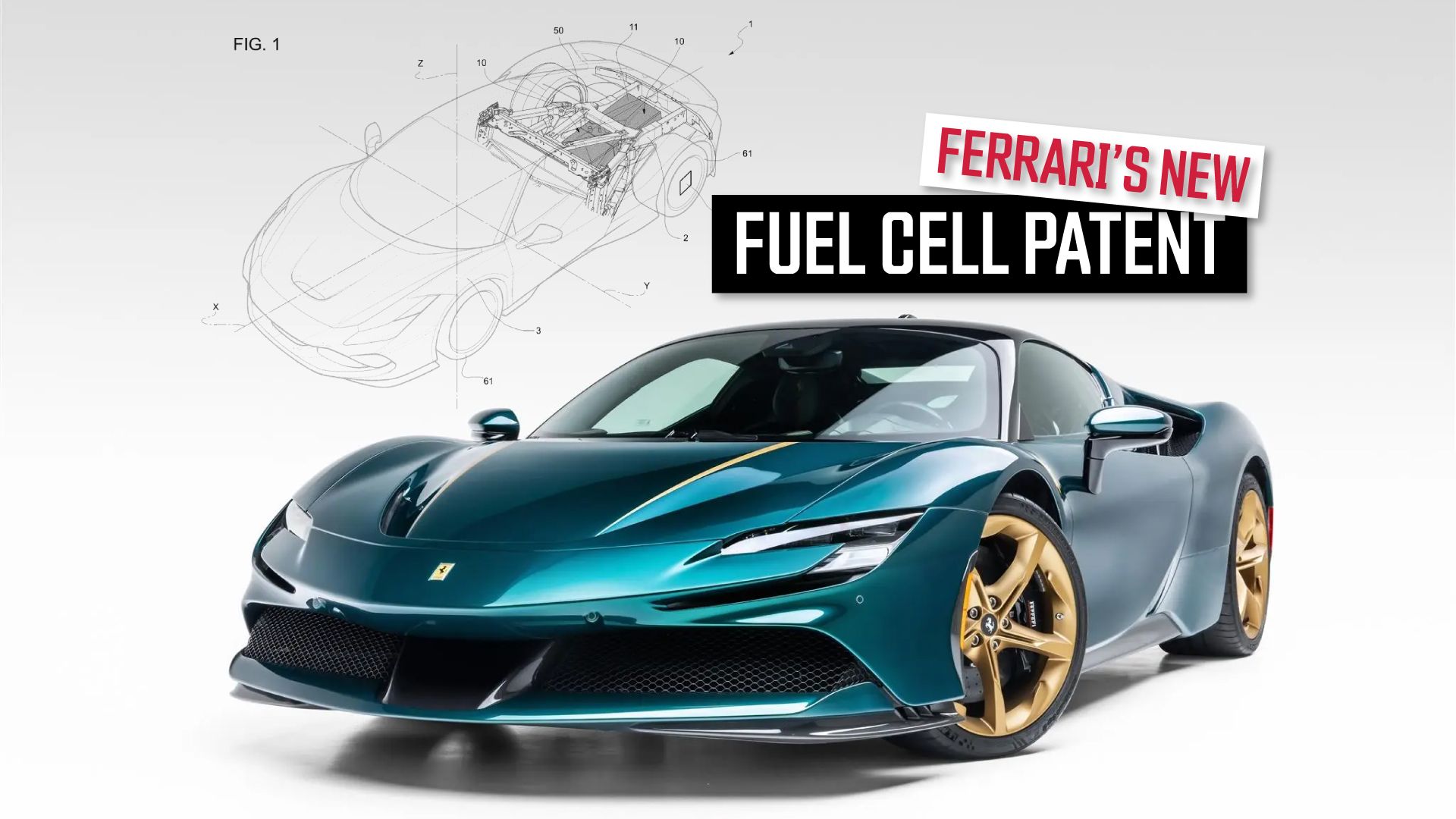Key Takeaways
- Ferrari’s new turbocharger design scavenges kinetic energy from the crankshaft, as well as using exhaust gases.
- Design includes variable intake system and crank-mounted gear set.
- The patent looks excessively complex but may be a part of a broader hydrogen-powered innovation.
A couple of months ago, Ferrari patented an upside-down hydrogen engine with gear-driven superchargers, and now the automaker has explained how the concept would work with turbochargers instead. The new technology was discovered by CarBuzz at the United States Patent and Trademark Office. Unlike the abovementioned patent, Ferrari makes no mention of hydrogen power this time, but it’s worth noting that the reason Ferrari is working on an inverted engine design in the first place is space.
Ferrari
Ferrari is an Italian manufacturer of sports cars, supercars, and luxury grand tourers founded by and named after Enzo Ferrari in 1939 – originally as Auto Avio Costruzioni due to legal complications with Alfa Romeo. Ferrari famously only produced roadgoing sports cars as a means of funding its racing exploits, which include multiple F1 World Championships and wins at Le Mans and various other prestigious races. Today, Ferrari is one of the most valuable brand names in the world, limiting production of its highly-sought-after models to maintain desirability, which is in no short supply when they’re powered by some of the world’s most advanced V6, V8, and V12 engines.
- Founded
- 1939 (as Auto Avio Costruzioni)
- Founder
- Enzo Ferrari
- Headquarters
- Maranello, Italy
- Owned By
- Publically Traded
- Current CEO
- Benedetto Vigna
With this novel approach, Ferrari should be able to create more room for hydrogen tanks and other ancillary systems. In the new patent, Ferrari notes that large turbochargers are not very efficient at low engine speeds. Conversely, small turbochargers spool up quickly but suffer with high-speed performance due to limits in the volume of air they can process. Ferrari’s new innovation solves these issues.
Variable Boost In Various Ways
Ferrari’s new patent builds on the well-known principles of turbocharging, in which exhaust gases spool the same turbine shaft that spins the intake compressor. These intake gases are fed through an intercooler, lowering the temperature of the charge for maximum efficiency. In Ferrari’s design, dual intakes feed air to the engine. Once compressed, this intake charge goes to an intercooler, but in the Ferrari design, the intercooler is split in two and has a bypass valve between each half.
The idea is that the ECU can close this valve at low rpm to accelerate the increase of pressure in the intake manifolds; effectively, two intake sources pressurize a chamber that would otherwise only be handling one intake’s air volume. With more pressure in the plenum, the engine can inject more fuel and the turbocharger can spin up faster.

Related
Ferrari Develops Hydrogen Fuel Cell With Aerodynamic Properties For Emissions-Free Supercars
Maranello’s design for a hydrogen-fed electric vehicle saves space, lowers height, and improves aerodynamic efficiency,

Add CarBuzz to your Google News feed.
Combining The Best Attributes Of A Turbo And A Supercharger
The second part of the invention is where things get more complex. As mentioned at the outset, this engine is inverted, which means that the crankshaft is one of the highest parts of the engine. Coaxially, a gear set is placed alongside the crankshaft and has its own clutch mechanism, with an output shaft connected to the turbocharger’s turbine shaft. At low rpm, the clutch would move this gearset onto the crankshaft, thereby forcing the turbocharger to spool up with the crankshaft.
Ferrari says numerous gears (three or more) would be employed, and the clutch would have the ability to slip depending on the speed of the crank/turbo. This transmission for the turbo(s) would operate independently of the regular output shaft, meaning that it could help to speed up the turbo even when the car is stationary or in neutral. Once the forced induction system is at optimal speed, the bypass valve on the intercooler would open and the clutch would decouple the turbo(s) from the crank.
There’s A Simpler Way To Do This
Automakers are always looking to extract more performance and efficiency from their cars, and making the art of turbocharging more efficient is one of the most effective ways of achieving that. However, we can’t help but think that this Ferrari innovation may be too complex even for Maranello’s masterpieces. Over at Porsche, the need for more power and the disdain for turbo lag that all enthusiasts share has been solved through a much simpler idea: an electrified turbocharger.

Related
All The Ways Porsche Is Fighting To Keep The 911 Combustion-Powered
Porsche won’t let the iconic 911 go down without a fight.
With an electric motor helping to make up for lag at low engine speeds, Porsche has been able to fit the new 911 GTS T-Hybrid with a bigger single turbo that replaces the small twins on the old car. Still, we applaud Maranello’s engineers for exploring the unlikely, and if ideas like these keep combustion alive, we’re all for them.
Patent filings do not guarantee the use of such technology in future vehicles and are often used exclusively as a means of protecting intellectual property. Such a filing cannot be construed as confirmation of production intent.
#Ferrari #Solves #Turbo #Lag #Turbo #Gears #Upside #Engine


